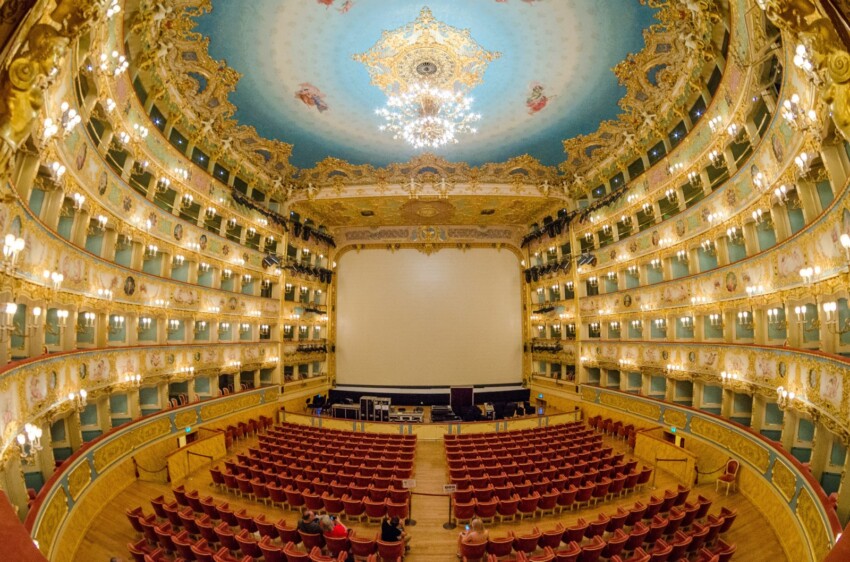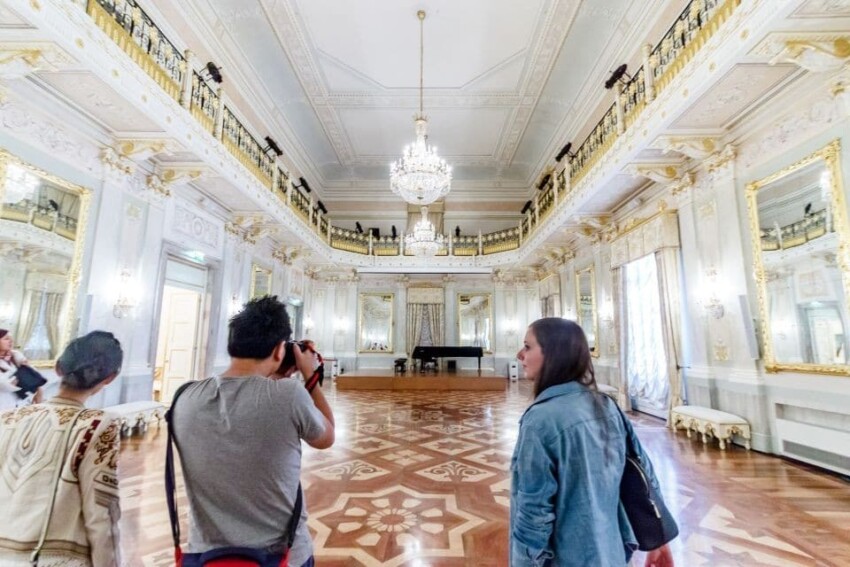
The Gran Teatro La Fenice (The Phoenix Theater) is the main opera house in Venice and was built between 1790 and 1792, designed by the Venetian architect Gian Antonio Selva, who was an important exponent of neoclassicism. The theatre was inaugurated on 16 May 1792 on the occasion of the ‘Feast of the Sensa’, which commemorated the ascension of Christ to heaven. For the inauguration, the Fenice staged the premiere of Giovanni Paisiello’s ‘I Giuochi d’Agrigento’ with Giacomo David, Gaspare Pacchierotti and Brigida Banti. The theatre was then, as it still is today, one of the most prestigious theatres in the world.
During the 19th and 20th centuries, La Fenice was the venue for numerous other premieres of works by great 19th century Italian artists such as Gioachino Rossini, Vincenzo Bellini, Gaetano Donizetti and Giuseppe Verdi. Also in the 20th century, several world premieres were held here with internationally renowned artists such as Igor Stravinsky, Benjamin Britten, Sergei Prokofiev, Luigi Nono, Bruno Maderna, Adriano Guarnieri, Luca Mosca and Claudio Ambrosini. Over the years, unfortunately, the Teatro La Fenice has twice been hit by fires that seriously damaged its interior. After these episodes, the theatre was always promptly rebuilt and restored to its original beauty.
Nowadays, the Teatro La Fenice is considered one of the most important theatres in the world, it is home to important opera and symphonic seasons and every year it organises the traditional New Year’s Concert.

The La Fenice Theatre has undergone several renovations and refurbishments over the centuries. It was not only the two fires that occurred that required many areas to be rebuilt, but also the French domination and Napoleon’s visit to Venice brought many changes as La Fenice had taken on the role of ‘State Theatre‘ at that time.
Externally, the La Fenice Theatre now has a neoclassical façade designed by Gian Antonio Selva and consisting of two orders. In the first is a pronaos with four Corinthian columns, while above are the niches housing the statues of Dance and Music, created by Gian Battista Meduna. In the atrium just below the pronaos are commemorative plaques of personalities who contributed to making the theatre’s history, such as Carlo Goldoni, Antonio Selva, Gioacchino Rossini, Ermanno Wolf-Ferrari and Giuseppe Verdi.
Inside is the Apollinea Hall in neoclassical style that boasts four tiers of boxes and a gallery. Then there is the Sala del Teatro, which boasts a capacity of 1,500 spectators. The Theatre Hall was first fully restored in 1936 and then in the year two thousand following an arson attack on the building. The hall has five tiers of boxes and was meticulously decorated with stucco, painted panels and gold carvings. The theatre also houses a permanent exhibition dedicated to the singer Maria Callas.
On a trip to discover Venice, a visit to the La Fenice Theatre is definitely a must.
To visit the La Fenice Theatre, tickets cost:
An audio guide available in 10 languages is included in the ticket price.
If you would like to take part in the tour of the Gran Teatro La Fenice, we advise you to buy your ticket directly online: you will avoid wasting time at the ticket offices and you can comfortably organise your holiday in Venice.
The La Fenice Theatre in Venice can be visited every day from 9:30 am to 6:00 pm.
The La Fenice Theatre can be easily reached on foot or by public transport.
From St Mark’s Square the theatre is approximately 500 metres away and can therefore be reached on foot in a few minutes.
Alternatively, you can take the vaporetto:
FromVenice Marco Polo Airport the Theatre can be reached by the Alilaguna public service. For those arriving by car, the closest car parks are at Tronchetto and Piazzale Roma. From these car parks it is then necessary to take the vaporetto (or walk) to the Theatre.
The Teatro la Fenice in Venice was founded by the Nobile Società dei palchettisti, which had to cede the Teatro San Benedetto to the Venier family due to a court settlement. Having lost the theatre, the Noble Society decided to build a new one that would be called Teatro La Fenice, after the mythological being that is able to be reborn from its own ashes after death. A tender was opened for the construction of the theatre, which was won by architect Gian Antonio Selva. The construction of the building required the destruction of several buildings and houses and this caused controversy and protests from the population.
Construction of the theatre took approximately two years and it was inaugurated on 16 May 1792 with the opera ‘I Giuochi d’Agrigento’ by Giovanni Paisiello. During French rule, La Fenice was elevated to State Theatre and various works were carried out to welcome the visit of Napoleon Bonaparte, which took place on 1 December 1807. In addition to adorning the hall in celeste and silver, in the Empire style, the cantata ‘Il giudizio di Giove’ by Lauro Corniani Algarotti was performed for the occasion.
On 13 December 1836, a terrible fire destroyed the theatre hall and part of the theatre, while the atrium and the Apollo rooms were spared from the fire. Thus, the company that owned the theatre decided to commission the brothers engineers Tommaso and Giovan Battista Meduna to rebuild the complex. Other areas of the theatre then underwent various restorations, but the most important were in 1854 and 1936.
On 29 January 1996, another devastating arson attack hit the theatre, which unfortunately had to remain closed for several years. The reconstruction work was carried out according to the motto ‘as it was, where it was’, which had also characterised the reconstruction of St. Mark’s bell tower.
In the presence of the highest offices of state and live on television, Maestro Riccardo Muti opened the Inaugural Week on 14 December 2003 in the reconstructed Teatro La Fenice with the theatre’s Orchestra and Choir.
The Teatro La Fenice is located in the Sestiere di San Marco in Campo San Fantin, not too far from St. Mark's Square and the Basilica.
City Card allow you to save on public transport and / or on the entrances to the main tourist attractions.
